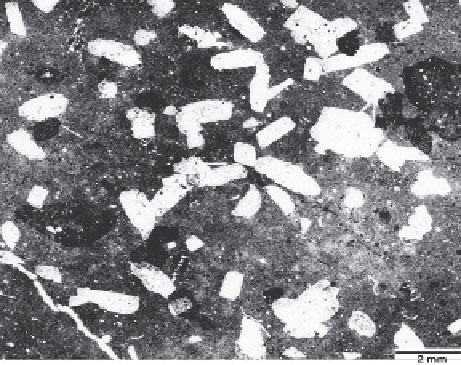Geology Reference
In-Depth Information
observed on the scale of outcrops and cores as well as
in microfacies samples. The studies must consider the
lateral and vertical development of depositional pat-
terns, depositional cycles, e.g. shallowing-upward se-
quences, and the rapid changes in physico-chemical
environmental controls.
Common small-scale microfacies include stratifica-
tion, occurrence of massive sulfates with gypsum crys-
tals, intercalation of thin marine carbonates, intervals
with reworked gypsum grains, and claystones with nod-
ular gypsum features (Aigner and Bachmann 1989;
Balzer 1997).
Other thin-section criteria are:
Depositional and diagenetic fabric
• lamination types,
• relation of layers (couplets, successive, unrelated,
disrupted),
• microfolds,
• microbial relicts,
• quiet-water ooids, peloids or siliciclastic grains en-
closed within evaporite layers,
• arenitic or ruditic resedimented gypsum.
Crystal fabric
• morphology and growing habits of gypsum crystals
e.g. single, twins (swallow tail), stellate clusters (Pl.
125/2, or in massive beds.
For classifications of evaporites based on structural
and textural criteria see Maiklem et al. (1969), Langbein
(1979) and Balzer (1997).
Fig. 13.4.
Calcite pseudomorphs
after idiomorphic euhedral
evaporite crystals formed in a near-coastal hypersaline la-
goonal environment. Dark micritic grains correspond partly
to black pebbles. Late Jurassic (Kimmeridgian): Immouzzer,
western High Atlas, Morocco. After Hüssner (1985).
quence consists of alternating laminae of white calcium
sulfate mineral and gray lamellae rich in dolomite and
organic carbon. Another common fabric is the alternat-
ing occurrence of dolomite layers and layers of gyp-
sum crystals.
Diagenetic structures
are abundant due
to the extreme solubility of evaporite minerals. A com-
mon diagenetic structure is
chicken-wire anhydrite
con-
sisting of elongated white anhydrite in a dark micro-
crystalline anhydrite matrix.
Nodular gypsum or anhy-
drite structures
are common in sabkha environments,
but should be used with caution for environmental in-
terpretations.
Enterolithic folding
is a structure charac-
terized by an intralayer crumbling (Pl. 125/4).
Evap-
orite-solution breccias
have a well-defined base and
may extend upward through many beds of different li-
thology (Sect. 5.3.3.3).
Most primary and diagenetic structures, e.g. lami-
nation patterns, chicken-wire and nodular structures as
well as the replacement of anhydrite after gypsum or
calcite after evaporite minerals (Fig. 13.4) can be stud-
ied in thin sections.
13.1.2.4 Phosphates
Phosphatic sediments form in different environments
- not only beneath upwelling systems, but also atop
seamounts, guyots and plateaus, on oceanic islands, and
on some shelves and in epeiric environments.
The formation of phosphorites includes two basic
processes: (1) Physicochemical or biochemical precipi-
tation of carbonate fluorapatite within the sediment, at
the sediment/water interface and/or during diagenesis.
Microbial contribution is important (Krajewski et al.
1994). (2) Hydraulic and biological reworking of pri-
mary phosphorites by which phosphatic grains are con-
centrated to form granular phosphorite.
Non-transported phosphorites may occur in any or
all of the principal phosphorite settings; many of them
are associated with stratigraphic condensation, deposi-
tional breaks and/or unconformities.
Granular phosphorites developed on shelves and in
epeiric seas and appear to dominate phosphorite oc-
currences in the Phanerozoic record (Glenn et al. 1994).
Phosphatic grains include peloids, compound grains,
Facies and microfacies studies of evaporites
The different environments in which evaporite for-
mation takes place are characterized by a great number
of sedimentary structures that are controlled by the con-
centration of various ions, temperature and organic
components present, and reflected by microfacies types.
Each variation produces differences in the style and
rates of sedimentation, no matter which evaporite min-
erals are present. Facies analyses of evaporite rocks and
evaporite-carbonate sequences require a differentiation
between primary facies characteristics and diagenetic
overprints (Schreiber et al. 1982). Both features can be

